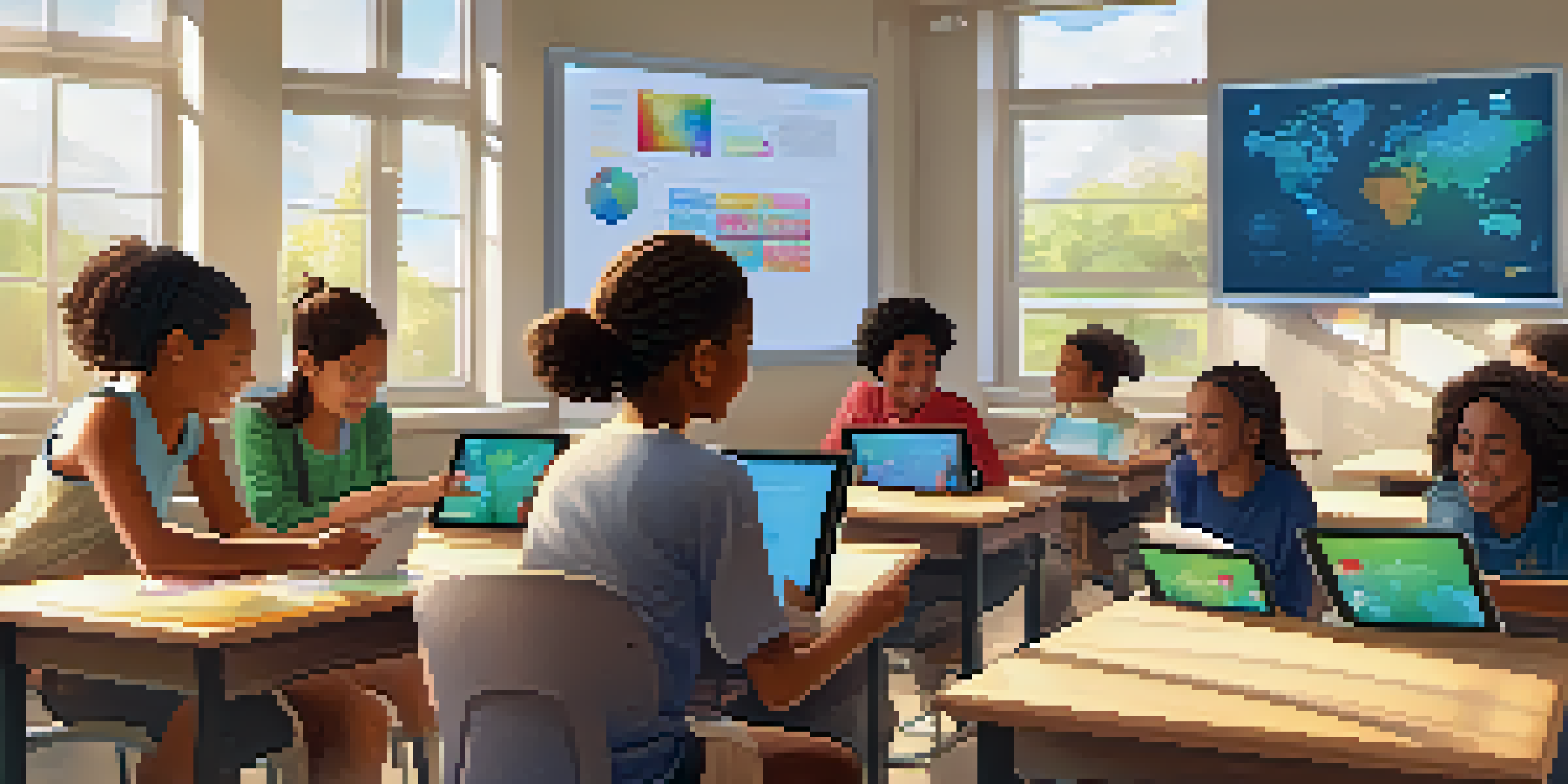The Role of Technology in Empowering Student Learning

Technology as a Learning Catalyst in Education
Technology serves as a powerful catalyst in modern education, reshaping the way students learn. With tools like interactive whiteboards and tablets, classrooms have become vibrant spaces where information is not just presented but experienced. This shift fosters a more engaging atmosphere, allowing students to take charge of their learning journeys.
Technology is best when it brings people together.
For instance, consider a classroom where students are using tablets to access interactive lessons. Instead of passively receiving information, they can explore topics in depth, ask questions, and collaborate with peers in real time. This active participation not only enhances understanding but also cultivates a love for learning.
Moreover, technology breaks down the traditional barriers of education, making it accessible to all. With online resources and platforms, students can learn at their own pace, revisiting challenging concepts as needed. This personalized approach empowers students by allowing them to tailor their learning experience.
The Impact of Online Learning Platforms
Online learning platforms have revolutionized education by providing flexible and diverse learning options. These platforms, such as Coursera and Khan Academy, offer a range of courses that cater to various interests and skill levels, making learning more inclusive. Students can choose what they want to learn and how they want to learn it, promoting a sense of ownership over their education.

Imagine a high school student passionate about coding. Instead of being limited to the school curriculum, they can explore countless online resources and tutorials, honing their skills outside the classroom. This self-directed learning not only fosters independence but also prepares students for a rapidly changing job market.
Additionally, online platforms often incorporate gamification elements, turning learning into a fun and engaging experience. By earning badges or completing challenges, students are motivated to progress further, making education not only more accessible but enjoyable.
Enhancing Collaboration Through Technology
Technology promotes collaboration among students, breaking down geographical barriers and encouraging teamwork. Tools like Google Classroom and Microsoft Teams enable students to work together on projects in real-time, regardless of their physical location. This collaboration mirrors the real-world work environment, preparing students for future careers.
The great aim of education is not knowledge but action.
For example, a group of students from different schools can collaborate on a science project using shared documents and video calls. They can brainstorm ideas, share research, and create presentations together, all while developing crucial communication skills. This experience not only enhances learning but also builds friendships and networks.
Moreover, these collaborative tools often foster a sense of community among learners. Students can provide feedback to each other and celebrate each other's successes, creating a supportive environment that encourages risk-taking and innovation.
Personalized Learning: Tailoring Education to Individual Needs
One of the most significant advantages of technology in education is the ability to personalize learning experiences. With adaptive learning technologies, educators can assess students' strengths and weaknesses, tailoring lessons to meet their specific needs. This targeted approach ensures that every student has the opportunity to succeed.
For instance, an educational app might adjust the difficulty of math problems based on a student's performance, offering more practice where needed. This personalized feedback helps students grasp concepts more effectively, ensuring no one falls behind.
Furthermore, personalized learning empowers students to take control of their education. They can set goals, monitor their progress, and choose resources that resonate most with them, fostering a sense of agency and motivation in their learning journey.
The Role of Virtual Reality in Education
Virtual reality (VR) is emerging as a transformative tool in education, providing immersive experiences that enhance learning. With VR headsets, students can explore historical sites, dive into the ocean, or even travel through the human body, all from their classroom. This level of engagement can significantly deepen their understanding of complex subjects.
Imagine a biology class where students can virtually experience the human circulatory system. Instead of memorizing diagrams, they can see the heart in action, observing how blood flows through the body. This hands-on experience not only makes learning more memorable but also sparks curiosity and enthusiasm.
Moreover, VR can cater to various learning styles, making it an inclusive tool for all students. Visual learners can benefit from seeing concepts in action, while kinesthetic learners can interact with virtual elements, creating a rich educational experience that meets diverse needs.
Data Analytics: Informing Educational Strategies
Data analytics plays a crucial role in enhancing student learning by providing insights into their progress and performance. Educators can analyze data from assessments, attendance, and engagement metrics to identify trends and areas that need improvement. This information is instrumental in informing teaching strategies and curricular adjustments.
For example, if data shows that students are struggling with a particular math concept, teachers can implement targeted interventions or additional resources. This proactive approach ensures that students receive the support they need to succeed.
Furthermore, data analytics can empower students by allowing them to track their own progress. By understanding their strengths and areas for growth, they can set specific goals and take ownership of their learning journey, fostering a growth mindset that is essential for lifelong learning.
Preparing Students for a Technology-Driven Future
As technology continues to evolve, it is essential to prepare students for a future where digital skills are paramount. Integrating technology into education not only enhances learning but also equips students with the necessary skills for tomorrow's workforce. From coding to digital communication, these skills are becoming increasingly important in various fields.
Consider a student who learns coding as part of their curriculum. They are not only gaining technical skills but also developing problem-solving and critical-thinking abilities that are highly valued in the job market. By fostering these skills early on, educators are preparing students for success in a technology-driven world.

Moreover, teaching students about the ethical use of technology is equally important. As they navigate the digital landscape, understanding issues like digital citizenship and online privacy will enable them to use technology responsibly, ensuring they contribute positively to society.